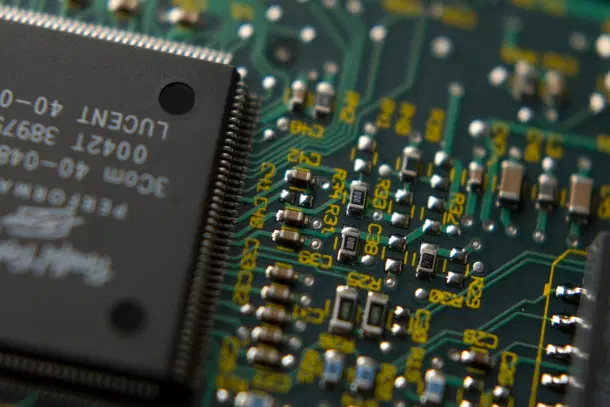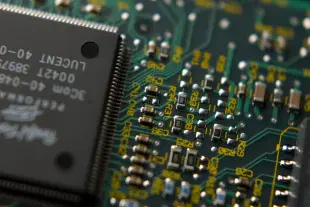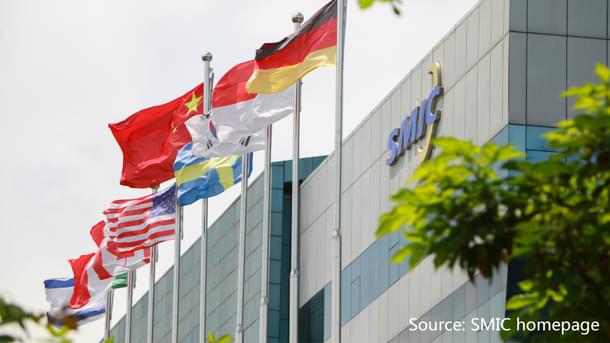Tech
Latecomer China’s Semiconductor Catch-up: Key Lessons India Can Take From The Chinese Experience
Dr Santhosh Onkar
May 08, 2022, 04:39 PM | Updated 04:41 PM IST
Save & read from anywhere!
Bookmark stories for easy access on any device or the Swarajya app.


With the conclusion of the SemiconIndia 2022 conference, alongside a series of agreements inked and a show of ambitious intent to increase the Indian electronics manufacturing footprint, it is an apt time to gather some understanding about how a relatively new player in the industry has reached the threshold of becoming a serious global player — the People’s Republic of China.
Some of China’s current challenges will be India’s challenges in the future. Any steps India can take now, based on the Chinese experience, would help mitigate problems and chart a different course.
Playing Catch-up
Developing countries tend to start late in a broad range of product and process technologies, but they devise strategies to leap, close the gap, and eventually either aspire to or indeed do challenge the incumbent leaders.
For instance, in the product segment, although South Korea (Samsung) started as a latecomer in the 1990s with the dynamic random access memory (DRAM), by the end of the millennium, it had already caught up with other East-Asian producers from Taiwan, Singapore, and Japan. Today, Korea leads the pack in memory products.
Similarly, in advanced semiconductor manufacturing process technologies, Taiwan started as a relative latecomer with the 7000 nm technology node borrowed from the United States (RCA Corporation) in the 1980s. It caught up with the rest of the world as a pure-play foundry alternative to integrated device manufacturers (IDMs) of the United States (US), Europe, and Japan. Today, Taiwan leads the pack with the 5 nm technology in production, leaving behind the once-pioneering countries.
China is the new gladiator in the arena of semiconductor manufacturing. As its semiconductor excursion is the most recent attempt to climb the silicon Everest, it has some important lessons for India.
Factors During Catch-up
Followers begin by engaging leader economies for technological learning. The state, through conducive policies, enables acquisition and assimilation of existing technology and accumulates technological capability to enhance their competitive advantages.
The term “catch-up” refers primarily to the closing of the gap in technological capabilities between the technology leader and the indigenous firms. Technology acquisition strategies during the catch-up phase start with partnerships or alliances and progress in various stages like purchase or technology transfer, collaboration, co-production, and co-development.
The role of governments is critical for followers to catch up with global leaders. Governments can direct this phase by making sector-specific policies. Government moves range from seeding the initial research and development (R&D) expenditure, protection of indigenous products, and the development of human capital. The role of other non-industrial actors like universities and research institutes is also critical to followers transitioning out of the catch-up phase by providing knowledge and qualified human capital to the industry.
Dragon Trail In The Semiconductor Industry
Jeon (Jeon, 2021) has classified the Chinese experience into two broad periods:
a) Catching up through inward internationalisation (1980s–1990s), and
b) Catching-up through indigenous capability (2000s–present)
Even though Chinese semiconductor development had its beginnings in the 1970s through acquiring Soviet technology, the attempts were mainly for cursory military needs and remained isolated and underdeveloped without any links with foreign firms until the beginning of the 1980s.
This changed with China reaching out to foreign players and with the establishment of state-owned semiconductor lines in 33 manufacturing facilities by the mid-1980s. Among the 33 facilities, only Huajing Group-owned Wuxi Factory No 742 reached the production targets of 10,000 three-inch wafers a month with acceptable quality due to considerable hand-holding from Toshiba, who were the technology transfer partner.
The subpar outcomes at the Chinese Academy of Science and other government subsidiary research institutes, which continued R&D and manufacturing activity at state-owned Factory 878 at Beijing, with Factory 19 at Shanghai Wireless Electronics managing a paltry yield of 20-40 per cent (that is, four of five chips were defective), meant that the strategy had to be overhauled.
Closer to the 1990s, China switched gears to encourage joint ventures (JVs) with global firms like Belgian ITT, Dutch Philips Semiconductors, and Japanese NEC Corporation.
China’s president, Jiang Zemin, was shocked at the rapid progress of the South Korean semiconductor industry when he visited Samsung’s semiconductor factory in 1995. Jiang stressed the need to “develop China’s semiconductor industry at all cost.”
Following this resolution, Project 908 was launched as part of the Eighth Five-year Plan, centred at Wuxi Hua Jing’s foundry production line with Lucent Technologies (the US) as the technology partner for process technology transfer, training engineers, and to provide IP design library.
But the project suffered from bureaucratic red tape for seven years before the factory would come online. This lethargy in approvals, building the factory, and approving the production line proved detrimental to the project since the products they produced became obsolete by the time production began.
Taking lessons from Project 908, the Ninth Five-year Plan flagged off Project 909. Nationwide resources were mobilised to support the project by removing bureaucratic barriers and red-tape policies. State-backed Shanghai Huahong took just two years to come online. It attempted an IDM JV with the Japanese NEC to bring DRAM chips to market and succeeded to be on time.
However, this effort couldn’t catalyse the Chinese industry, because the Chinese facility was primarily handled and managed by Japanese staff and knowledge transfer to Chinese counterparts was extremely limited in comparison to the production process. Huahong was forced to restructure the facility, bringing in new management and a new US partner, Jazz Semiconductor (which merged into the entity that, until the recent Intel acquisition, went by the name of Tower-Jazz Semiconductor).
Huahong pivoted to the pure-play foundry business model with Jazz Semiconductor and sent engineers to be trained at IMEC, Belgium. These engineers returned with skills to mount 180 nm process technology at home.
These two decades, from the 1980s to the turn of the millennium, were mostly state-owned enterprises dabbling with limited success. The combined output of Chinese semiconductor manufacturers accounted for less than 2 per cent of the world’s production, the majority of which was packaging and testing facilities of multinationals exploiting low-cost labour.
China’s manufacturing sector by the end of the millennium was, in summary, cheap labour occupying the lowest rung in the global value chain with slim profit margins. This dwindling profit and stiff global competition meant that the national support went away as swiftly as it was mobilised at the beginning of Project 909.
In early 2000s, China rejuvenated the industrial ecosystem with a more ambitious slew of policies to support Chinese semiconductor producers by providing tax holidays, enterprise tax reductions, localised subsidies to build infrastructure, and, additionally, constituting the most crucial National Talent Training Project in 2003 to provide much-needed human resource for industrial development. The result was evident in the mushrooming of fabless firms (where fabrication is outsourced) that grew exponentially from a paltry 15 in 1990 to 485 by 2010.
The other significant development of the year 2000 was the setup of the Semiconductor Manufacturing International Corporation (SMIC). This attempt was different from earlier attempts in these aspects:
The establishment of SMIC (with the backing of the Chinese government) followed the familiar Taiwan Semiconductor Manufacturing Company (TSMC) template; that is, it was set up by an expat Taiwanese American who had worked in Texas Instruments (the US) and TSMC.
In the beginning, SMIC employed 40 per cent of its technical staff from outside China and/or non-Chinese foreign citizens. Most of these engineers were Taiwanese, having worked in foundries like TSMC or United Microelectronics Corporation (UMC). These engineers brought the tacit knowledge of semiconductor engineering that is not easily codified. This knowledge was vital in building up the floor knowhow in the new company.
China, through SMIC, proactively pursued licensing from global partners — for example, 130 nm back-end logic from Toshiba, Japan; 100 nm logic from Chartered Semiconductor, Singapore; and 45 nm Bulk CMOS from IBM, the US.
By the end of the 2000s, global semiconductor manufacturers like Intel, Samsung (memory), TSMC, and UMC turned up to set up plants to cater to fabless firms in China.
By 2019, SMIC commenced 14 nm FinFET volume production; however, 90 per cent of their revenue is based on 40-250 nm nodes, which implies that their customers only rely on the Chinese foundry for producing low- or mid-range chips and not advanced chips.
In spite of the rapid growth of Chinese integrated chip enterprises in the 2000s, the industry, facing stiff global competition, failed to catch up in manufacturing. The cases of intellectual property theft and patent infringement filed against SMIC by TSMC, which the SMIC lost in the US courts, dealt a heavy blow to Chinese efforts.
The technological gap between SMIC and TSMC in chip manufacturing is increasing. With trade imbroglio in place, Chinese progress in semiconductor manufacturing has been severely dampened and curtailed to low-end chips. Further, Chinese fabless companies are compelled to rely on foreign supplies for advanced high-end chips, which top the list of high-value imports.

The Snakes To Avoid
The Chinese experience has some stark lessons for India to devise mitigation strategies. Even though president Jiang in the 1990s had the intent to “develop China’s semiconductor industry at all costs,” much like the current Indian premier, the government-dominated model of investment revealed fatal problems that slowed China’s catch-up strategy. The rigid bureaucratic system that created red-tape caused Project 908 to fail.
Even though Project 909 had slashed bureaucratic hurdles, the policy and financial support from the government was not consistent because the policy makers did not fully understand the significance of semiconductors to China’s technological prowess and future economic growth.
The Chinese mandarins failed to comprehend the semiconductor industry, its high investment, risk, and long-term gestation to accumulate technologies and build the necessary talent pool.
Further, the failure to achieve breakthroughs during the 2000s lay in a disconnect or a conflict between government support and a market-oriented approach. The semiconductor industry being highly competitive, with high costs of trial and error, and rapidly evolving technologies, led to fissure in the forces of government and the market, weakening both.
This clash is deeply rooted in China’s state-controlled model of technological development, in which government-sponsored projects would not produce commercially viable products while also failing to provide the necessary financial and policy support to encourage private companies to develop and catch up. Here are a few notable problems:
Bureaucratic Cold Shower And Talent Winter
The Chinese bureaucracy’s campaign-style catch-up strategy expects quick success, which is an anathema to all aspects of high-precision, high-quality semiconductor manufacturing. Chinese government officials in charge of science and technology did not encourage long-term R&D in fundamental innovation, but instead focused on short-term projects like packaging and testing.
Most of the investment went into the low-end domestic market, emphasising quantity instead of quality. This strategy, no doubt, gives quick results, making the performance of supervising bureaucrats look impressive in the short term, but it dents national progress by decades in the long term.
The lack of talent and the absence of an ecosystem to nurture talent organically or attract inorganic talent to the semiconductor industry doesn’t help. The fresh graduates lack experience or training due to the university-industry disconnect, and, additionally, the short technology cycle time impedes nurturing talents as it takes a long time to train engineers. To retain good talent locally in an attractive global scenario is an uphill task.
Disconnected Academic Research And Market
If the state-sponsored and/or subsidised R&D in government institutes and universities is disconnected from the market, the probability of evolving a commercially viable product ecosystem is a non-starter. The Loongson CPU attempt to produce an indigenous CPU is a striking example to demonstrate the double-whammy of short-sighted bureaucratic-style R&D using academia, which is disconnected from the market.
Indigenisation And Market-Orientation
The twin-failures of Project 908 and 909 and the laissez-faire capitalistic approach of the 2000s overemphasised playing catch-up through indigenous efforts devoid of cooperation with global companies (for example, the Loongson CPU Project). It was against the trend of joining the global production network, and, at the same time, milking global supply to meet local demand for semiconductor products.
Free-market competition would never allow a fledgling industry to take root without the consistent support of significant capital and technology infusion. For instance, China’s industrialists and venture capitalists seldom invested in the semiconductor industry before 2018 due to the huge financial risk posed by long-term investment, huge initial cost, and low return rate.
Lack Of Innovation Appetite And Catch-up Fatigue
The systemic inertia due to years of catch-up after introduction, assimilation, and stopping short of innovation has kept China in the follower mode for long. Project 909 showed that it is impossible to get state-of-the-art technology. One is compelled to start with an out-of-date technology as an introduction, assimilate it well, and then graduate to innovating at the frontier, based on assimilated technology, because the leaders can only stay leaders until they are at the forefront of innovation and excellence.
India will be prudent to watch out for these traps both from its past and four decades of Chinese experience. In the next part of this article series, the writer will highlight some ladders that have aided Chinese acceleration in order to increase its global semiconductor footprint and some stellar cases that India can take cues from.





